One of the most beautiful destinations in the state, Maroon Bells in Colorado is a mountain paradise everyone needs to visit at least once.
Maroon Bells has taken up residence on my bucket list for a while now, and it was incredible to finally visit! Keep reading for everything you need to know from the reservation system to the best hikes to check out.
Table of Contents
What is Maroon Bells?
Featuring two of the most photographed peaks in the Elk Mountains, Maroon Bells in Colorado is an iconic hiking area near Aspen. Also referred to as the Maroon Bells Snowmass Wilderness, this 181,973 acre wilderness was established in 1964. It is the fourth largest established wilderness area in the state of Colorado.
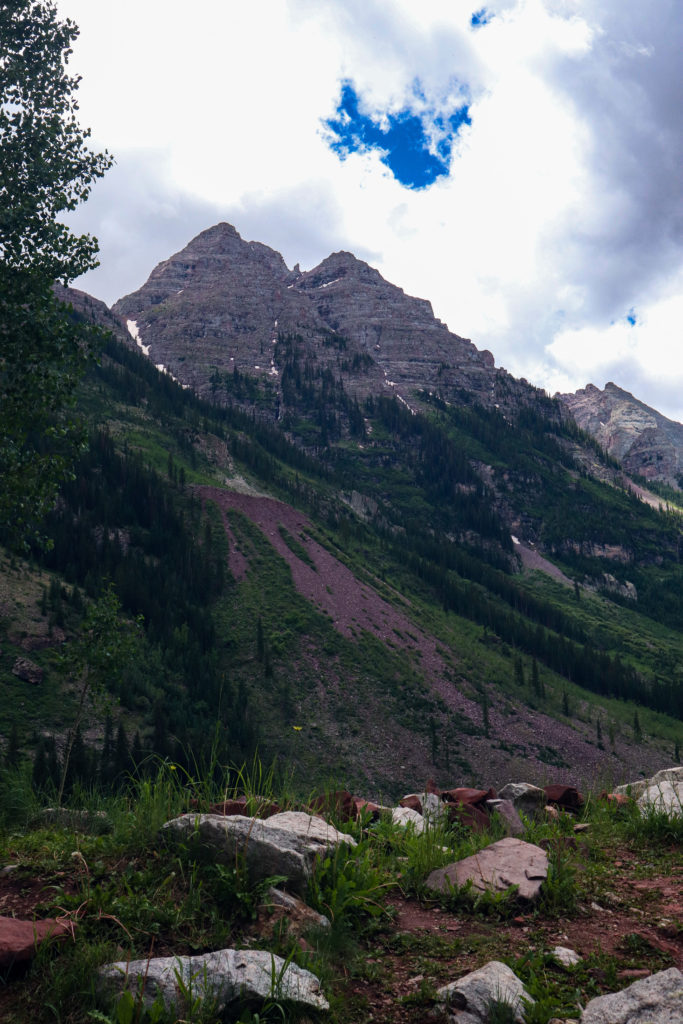
The wilderness area includes over 100 miles of trail winding through 9 mountain passes that stand over 12,000 feet. The area is also home to the Conundrum Hot Springs, bighorn sheep, elk, deer, and other wildlife.
There are also 6 peaks over 14,000 feet in the Maroon Bells Snowmass Wilderness. The most notable of these are Maroon Peak and North Maroon Peak, or the iconic Maroon Bells. These are named for their crimson color due to oxidation and their unique bell shape.
Unlike most Colorado mountains that are made of granite and metamorphic rocks, the Maroon Bells have a more unstable composition. They are made of mudstone that makes them dangerous to summit. They were even named “the Deadly Bells” after 8 mountaineers died there in 1965.
Pyramid Peak is another 14er that can be seen towering over Crater Lake off to the left of the Maroon Bells at the Maroon Bells Scenic Area. The peaks in this region are some of the most difficult 14er summits in Colorado.
The incredible Maroon Bells are best photographed at sunrise, but I’m sure a sunset wouldn’t disappoint either. Most visited in the warmer months, Maroon Bells in Colorado is known for its summer wildflowers in July and August and golden aspens in September and October. Regardless of what season you visit, I’m sure the peaks of the Maroon Bells will leave you speechless.
The History of Maroon Bells
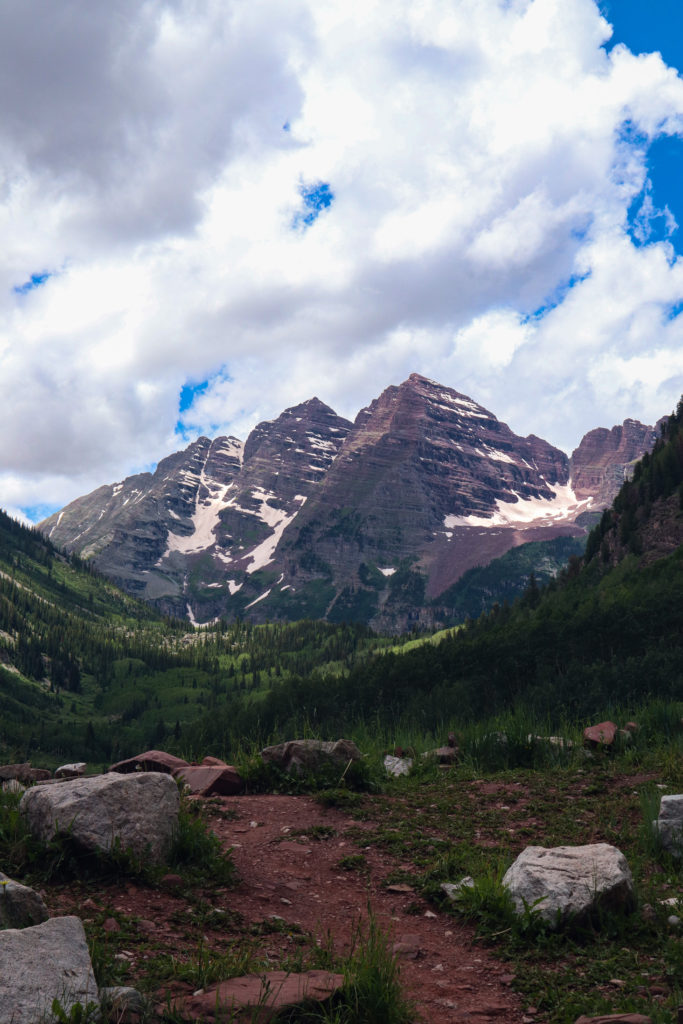
The formation of the Maroon Bells is a fascinating one. They were originally part of sediment from the Ancestral Rockies. This resulted in their layered appearance today. When the Rocky Mountains we see today rose, the mudstone of the Maroon Bells was exposed, and then shaped by glacial activity.
As we rode the shuttle bus towards Maroon Bells Scenic Area, our shuttle driver shared some of the history of the Maroon Bells.
Once word got out about this beautiful place, people flocked to the area. A meadow now designated as the “Wedding Meadow” was the scene to many weddings. Guests parked all over the meadow in their rush to attend these weddings. The ecosystem began to change slowly as a result of this careless tourism.
As things worsened, rangers couldn’t ignore what was happening at Maroon Bells. Wildflowers near the road began to die and the health of the aspen trees began to decline. In 1977, a parking and shuttle reservation system was implemented to reduce vehicle emissions. The Wedding Meadow was closed, and the Maroon Bells Amphitheatre was constructed for small weddings held in the shadow of the Maroon Bells. Since then, the ecosystem has stabilized, but this area can only continue to thrive with the help of everyone.
With over 300,000 people visiting the Maroon Bells every year, it’s important that everyone does their part to follow Leave No Trace Principles and leave this beautiful place better than they found it.
How to Visit Maroon Bells in Colorado
Best Time of Year to Visit
The best seasons to visit Maroon Bells are summer and fall. Maroon Creek Road opens mid-May and closes at the end of October every year. Exact dates are weather-dependent. But no matter what season you visit, you’ll find yourself in awe.
Summer
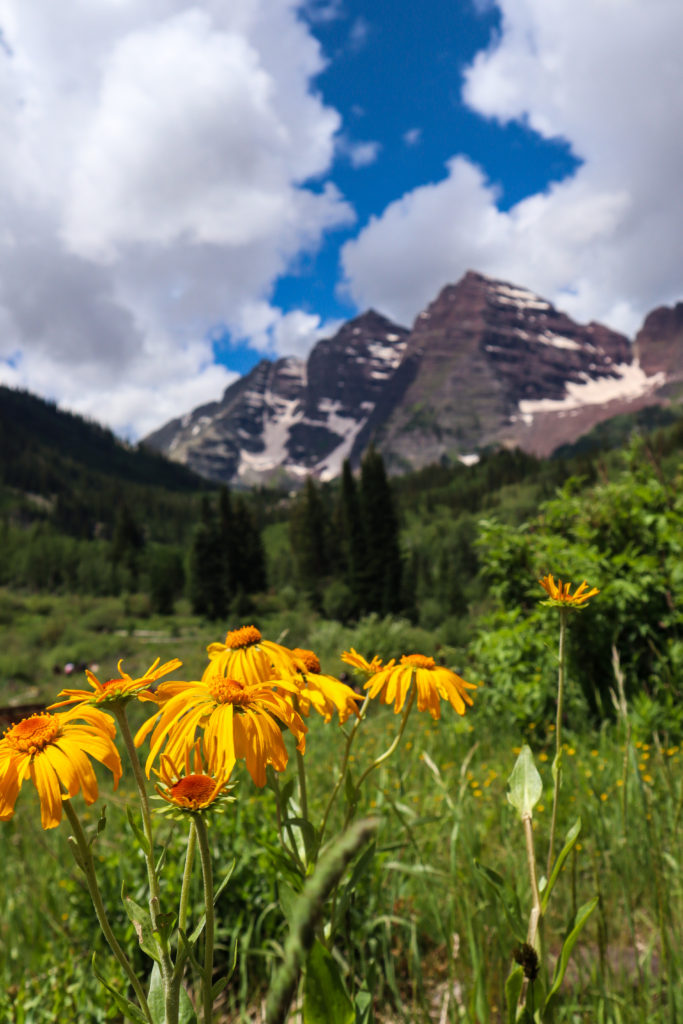
In July and August wildflowers bloom in the mountains. All the snow has melted, and the mountain passes open up for great backcountry adventures. Temperatures are warm, but always a little cooler at higher elevations.
You will also have to be prepared for Colorado’s classic summer monsoons. Watch out for unexpected or expected thunderstorms that might pop up in the afternoons. If you’re sticking close to the visitor center, these shouldn’t pose much of a problem, but in the backcountry, you won’t want to find yourself above tree-line.
Maroon Creek Road is open during the summer, which makes the area much easier to visit, but also means that the parking and shuttle reservation system is up and running.
Fall
In September and October, Colorado’s short-lived fall graces the mountain ranges. You can find golden aspens spread across the Maroon Bells Snowmass Wilderness and catch some pretty epic reflections. The weather will be cooler and monsoon season will have ended.
Your only concern will be winter weather looming on the horizon, which might impact when Maroon Creek Road closes for the season. Colorado peak foliage is also very short-lived, so make sure to check weather reports and reviews for the area before visiting.
As with the summer months, you will have to be mindful of the parking and shuttle reservation system that is in place until Maroon Creek Road closes for the season.
I think everyone needs to add fall at Maroon Bells to their travel bucket list. I know it’s on mine!
Winter/Spring
And just because Maroon Creek Road closes in the winter, doesn’t mean that Maroon Bells is devoid of winter adventures. While it’s a little more challenging to see the iconic mountains, it’s not impossible.
You’re in for a 12.8 mile round-trip along Maroon Creek Road just to access the Maroon Bells. You can start at T-Lazy Ranch to begin this adventure. The road remains open to cross-country skiing, snow biking, hiking, or snowmobiling. The road is also groomed with cross-country ski and snowmobile tracks.
You can even find snowmobile tours to Maroon Lake at T-Lazy-7 Ranch if the weather cooperates. Find more info on this here.
Parking and Shuttle Reservations for Maroon Bells in Colorado
In order to preserve Maroon Bells Snowmass Wilderness and reduce vehicle emissions, the number of vehicles allowed to drive along Maroon Creek Road is limited. A reservation system is in place during the months that the road is open from May to October. A shuttle system is also available to provide transportation to the area.
If you wish to bypass any reservation systems, you always have the option to walk or bike/e-bike Maroon Creek Road to the Maroon Bells Scenic Area. This will mean at least 12.8 miles round trip if you park at T-Lazy-7 Ranch. This distance doesn’t include any exploration you might want to do once you reach the Maroon Bells Scenic Area.
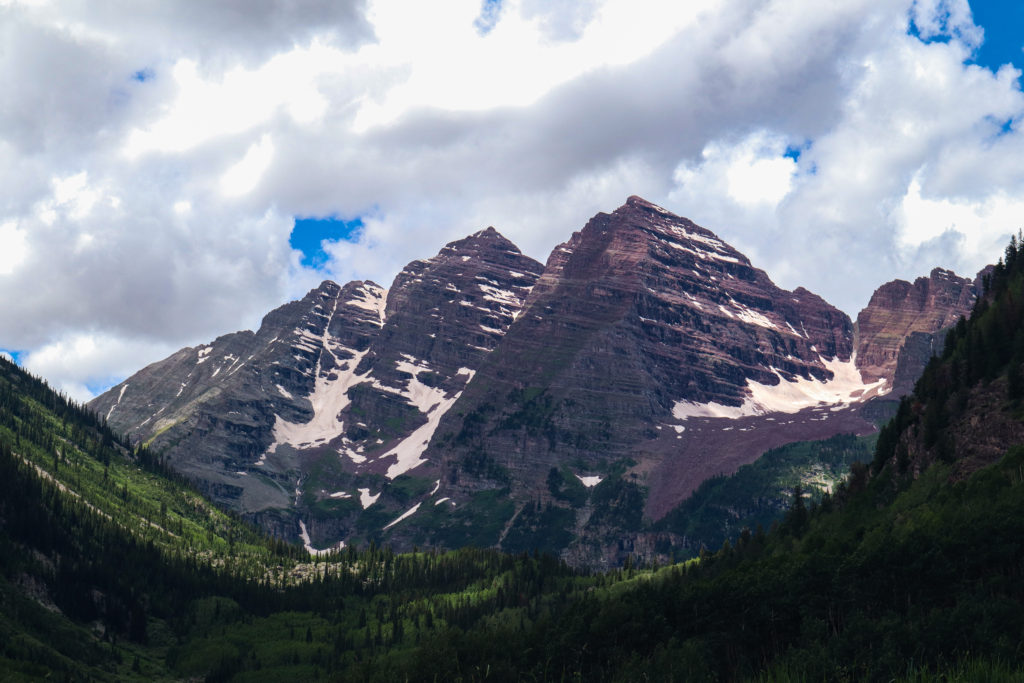
Parking Reservations
Obtaining a parking reservation means you can self-drive Maroon Creek Road and explore the Maroon Bells in Colorado without relying on the shuttle system. All parking reservations are $10 and must be reserved online here. If you have an America the Beautiful Pass or a Maroon Bells Annual Pass, you can make this parking reservation for free.
These are the available parking reservation options:
- Day Visit (12am-4:30pm)
- Evening (5pm-12am)
- 24-Hour (Midnight-Midnight)
- 2-Nights Overnight (6am-6pm, 60 hours total)
These reservation times apply for the entirety of the time that Maroon Creek Road is open. However, from late May to mid-October when the shuttle is running, there are a few special things to note. Day Visit and 24-Hour reservations must arrive before 8 am. In addition, anyone with a 2-Nights Overnight reservation is not allowed to arrive between 8 am and 5 pm.
The dates before and after the shuttle is operational are considered early and late season and have separate reservation portals.
Drop-offs are allowed from 6 am to 8 am, but the hiker must have a one-way shuttle pass for their return trip.
Shuttle Reservations
The shuttle to Maroon Bells Scenic Area typically runs from the week before Memorial Day to the middle of October.
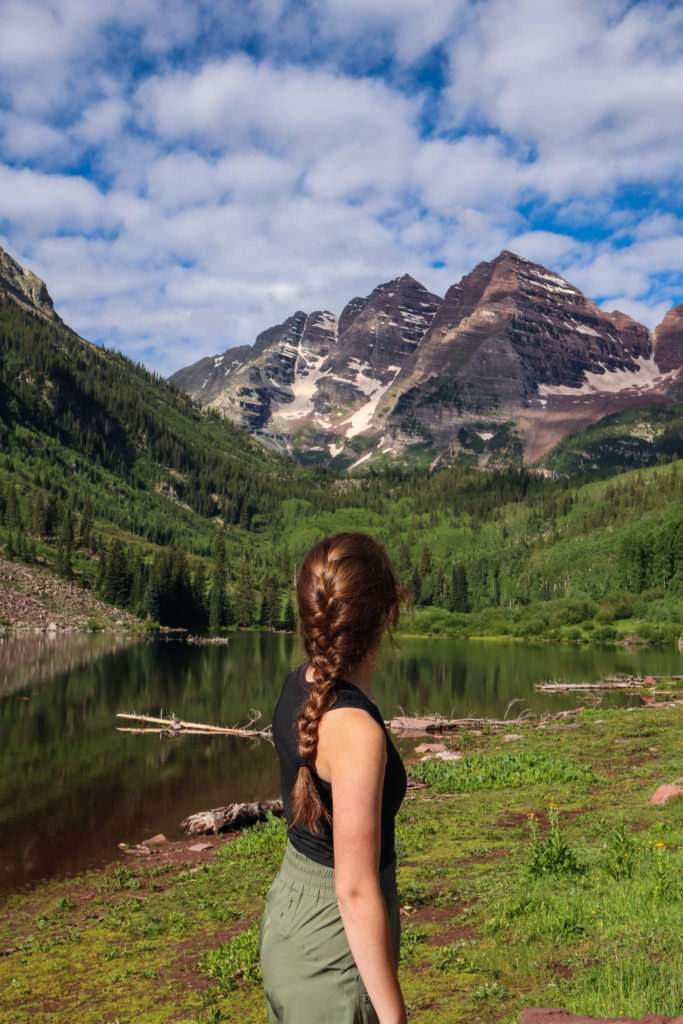
Although the shuttle may seem like a hassle, the information given by the shuttle driver on the drive was very interesting. I also felt like I was doing my part to not contribute further to harmful vehicle emissions in the wilderness area. The disadvantage is not getting to photograph the iconic Maroon Bells at sunrise.
The shuttle system bound for Maroon Bells departs from Aspen Highlands Ski Area at 8 am every morning. The last outbound shuttle leaves at 3 pm and the last shuttle leaving Maroon Bells Scenic area leaves at 5 pm. If you miss the last shuttle, there’s a long walk of shame in store for you.
Despite the possibility of some tickets being available on the morning you wish to visit, prices may be higher, so it’s best to book ahead. You can do so here.
Round-trip prices for the shuttle are the following:
- Adults: $16
- Seniors over 65: $10
- Children under 10: $10
You can also purchase a one-way ticket downhill from the Maroon Bells Scenic Area to Aspen Highlands Ski Area. These are available by advance reservation for $10.
Parking
To get to Aspen Highlands Ski Resort you can find parking in Aspen take a free shuttle from Rubey Park, but you’ll want to plan plenty of extra time.
The other option is to park at the Aspen Highlands Parking Garage. This is what we chose to do. Parking fees are $6/hour with a maximum of $40/day. This is a little steep, but the more people in your vehicle, the cheaper it gets. We had 4 people, so it only came out to $10/person after we maxed out the fee limit for the day.
Taking the Shuttle
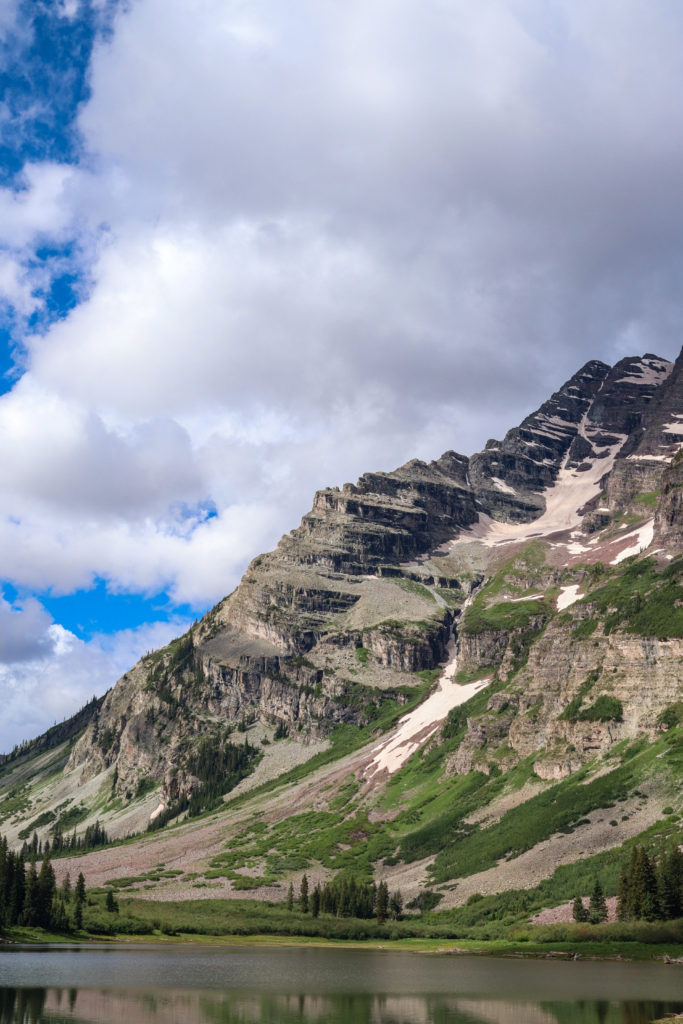
They do ask that you arrive at the Maroon Bells Shuttle Welcome Center 45 minutes prior to your shuttle time. This was actually really nice because it allowed time to go get our group boarding pass, find a bathroom, and even hit up the coffee shop before our departure.
Make sure you take a picture of your boarding pass and store it somewhere secure! They will not let you on the return bus without it and walking back wouldn’t be ideal.
Get in line 10 minutes before your departure time. If you miss your shuttle, you will not be allowed on another one. We chose the earliest time at 8 am and met a lot of people heading out to backpack the Maroon Bells.
The shuttle ride takes around 30 minutes and has beautiful views. When you get on, snag a seat on the right side of the bus for the best vantage point. The tour information was so interesting and worth the shuttle experience.
Dogs are allowed on the shuttle (please note that Maroon Bells Scenic Loop Trail is not dog-friendly, while other trails are) and bicycles can even be loaded on the front for a one-way trip.
I had never taken a shuttle for a hike before this, but it was actually a great experience and I’d recommend it for your first time at Maroon Bells in Colorado!
Camping in Maroon Bells Snowmass Wilderness
Although staying at a fancy hotel or Airbnb in Aspen is always a great option, the best way to experience an area is to camp in it. I’ve included the details for the three campgrounds right along Maroon Creek Road as well as a couple others in the area that I’ve personally stayed at.
Campgrounds Along Maroon Creek Road
For the optimal location for your Maroon Bells adventure, you might want to consider one of these campgrounds along Maroon Creek Road. These campgrounds are very popular, and sites fill up fast. Arrive early for first-come, first served sites and plan well in advance if you want to stay here.
The three campgrounds all cost $15/night to stay at. A vehicle pass for Maroon Creek Road is also required for these sites at $5 for a 5-day permit. In addition, all three campgrounds are dog-friendly, as long as they’re kept on a 6-foot leash at all times.
Silver Bell Campground
At an elevation of 8,460 feet, Silver Bell Campground sits in the aspen grove along Maroon Creek Road. Its 14 sites include tent-only, walk-in, and standard sites for RVs. Expect amenities like picnic tables, fire rings, and vault toilets.
While some of these sites are available for reservation online and should be booked well in advance, the walk-in sites require a visit to the Maroon Bells Welcome Station on the day of arrival. Find more details here.
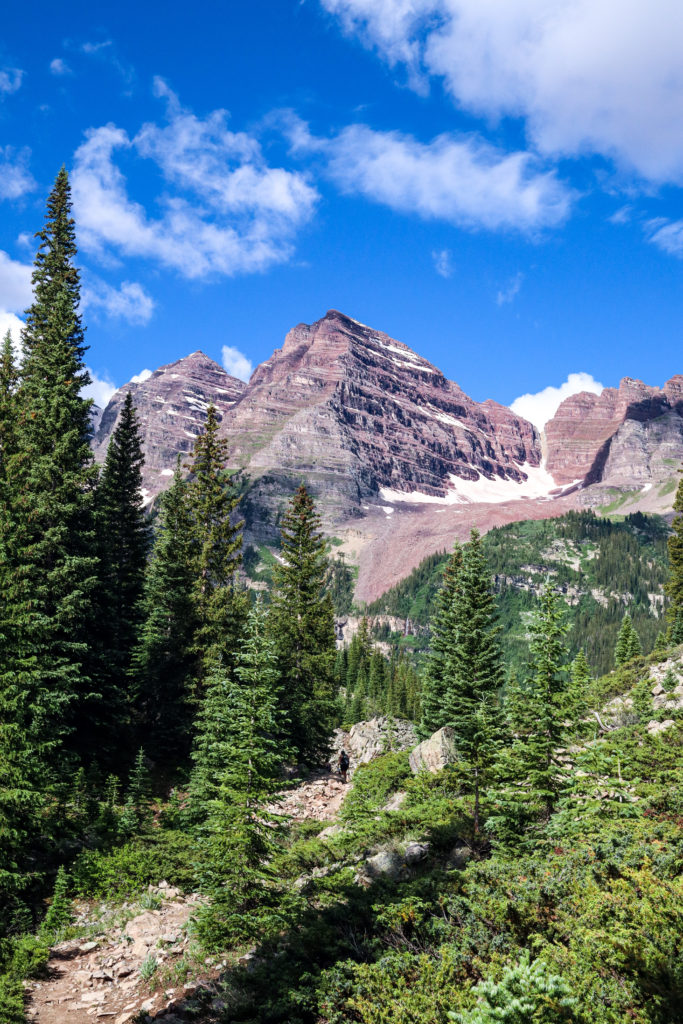
Silver Queen Campground
Further up Maroon Creek Road at 8,700 feet, Silver Queen Campground offers views of Pyramid Peak and the Maroon Bells from between the surrounding aspen grove. There are only 5 standard campsites for use by tents, trailers, or RVs. Amenities include picnic tables, fire rings, vault toilets, and drinking water.
Reservations for this campground are available online, so you’ll want to secure your sites well before your trip. You can find more details here.
Silver Bar Campground
Silver Bar Campground is adjacent to the Maroon Bells Welcome Station towards the beginning of Maroon Creek Road. It sits at 8,520 feet along Maroon Creek. This is a primitive campground with 4 tent-only walk-in sites. The only amenity available here is centralized vault toilets. Find more details here.
Other Campgrounds Near Maroon Bells
Within an hour of the Aspen area, two campgrounds that I’ve personally stayed at and would recommend are Difficult Campground and Little Maud Campground. Check back later for a link to a more detailed blog post on these campgrounds and more!
Camping Gear List
There’s so many different things to remember when packing for a camping trip. That’s why I made a FREE Camping Checklist to make it a little easier. Subscribe to my monthly newsletter here to get your checklist!
If you’re starting from scratch on your camping gear, here are a few suggestions for the essentials:
- Coleman Skydome Tent* (4 person is best for 2-3 people)
- Klymit Static V Sleeping Pad*
- Kelty Tuck 0 Sleeping Bag (great even in summer if you run a little cold like me)
- Fenix Lantern* (very bright, but also small and convenient for backpacking)
*this signifies an affiliate link. You can read more about what this means here.
Hiking at Maroon Bells
From backpacking to long day trips, to easy walks, there’s something for everyone at Maroon Bells. There are endless trails available in this area, including summiting the Maroon Peaks and Pyramid Peak. These three 14ers are considered three of the most difficult in the state of Colorado.
Highlighted below are some of the most popular trail options to help you plan your visit.
Popular Trails at Maroon Bells
Maroon Bells Scenic Loop Trail (Easy)
This is the most popular hike at Maroon Bells for a reason: it’s easily accessible and offers incredible views. If you’re looking for a short hike and just want to soak up the views of these incredible mountains, try this trail! This trail features two bridge crossings and epic views of the wildflowers in the summer and the aspens in the fall that can be enjoyed by a range of ability levels.
Even if you opt for a longer trail like Crater Lake or Maroon Creek Trail, this trail is a great add-on to really maximize your experience here. We added on most of this loop to our Crater Lake hike and loved the views. We even saw a moose alongside this trail as we headed towards Crater Lake!
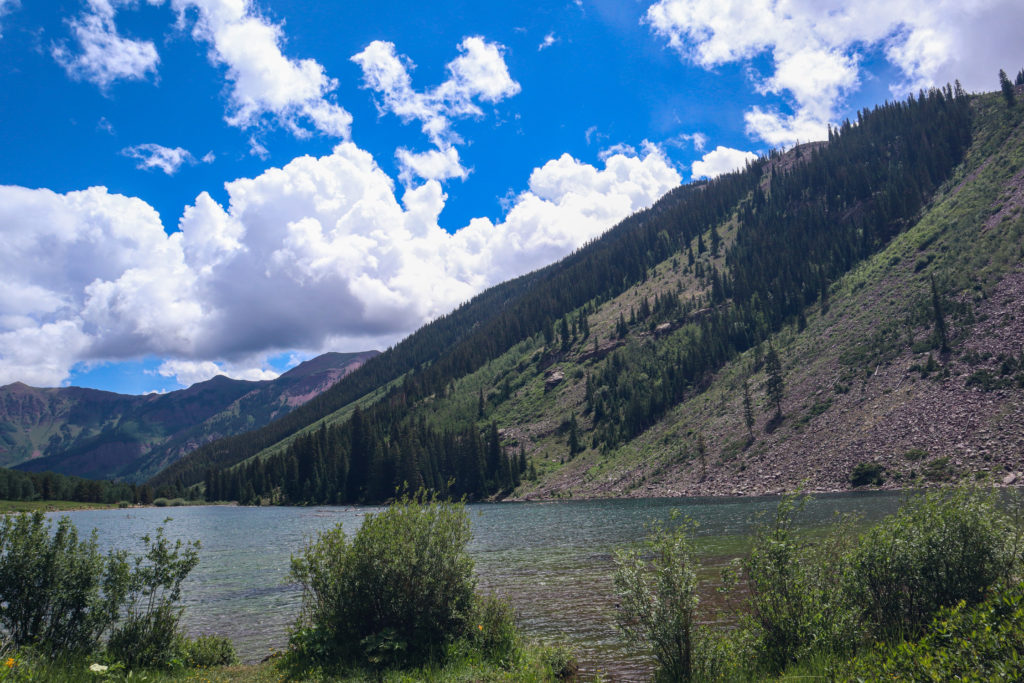
Trail Stats (via Alltrails)
- Distance: 1.9 miles
- Elevation Gain: 160 feet
- Difficulty: Easy
- Route Type: Loop
- Duration ~1 hour
- Dog-Friendly: No
Crater Lake (Moderate)
This is the main hike that we did during our visit to Maroon Bells Snowmass Wilderness. We combined it with part of the Maroon Bells Scenic Loop Trail to get all the views. This trail has some rocky incline but is very manageable. And that’s coming from a Michigan native. The more difficult sections take you through a breathtaking aspen grove and emerge into looming mountain views, which makes them that much easier.
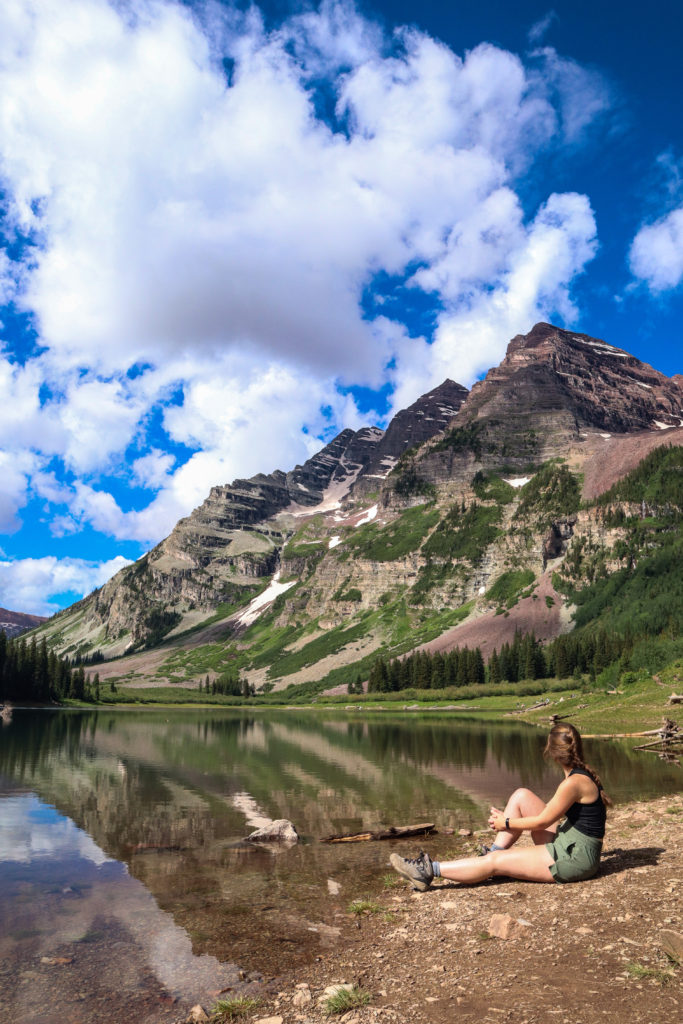
Crater Lake is a giant reflection of the looming Maroon Bells, which you’ll find are up close and personal at this point. Lake reflections are typically better earlier in the day, so if this is something you want to see, plan for an early hike.
It is also important to keep in mind that Crater Lake can dry up in September and October once fall weather sets in. However, wandering through the golden aspen grove might be worth it either way. Always check trail conditions and reviews ahead of time to see what’s in store for your visit.
With adequate breaks and exploring around Maroon Lake, this trail took us around 3 hours, but you can definitely take it faster or slower. We wanted to really soak up this place and make our shuttle tickets and parking permits worthwhile.
The views from Crater Lake and the rest of this trail are some of the best I’ve seen in Colorado, or maybe ever.
If you want to do a moderate amount of hiking at Maroon Bells but aren’t ready for any of the more ambitious routes, this is my recommendation for you!
Trail Stats (via Alltrails)
- Distance: 3.5 miles
- Elevation Gain: 688 feet
- Difficulty: Moderate
- Route Type: Out and Back
- Duration: ~2 hours
- Dog-Friendly: Yes, on leash
Maroon Creek Trail (Moderate)
This trail was actually recommended by our shuttle bus driver! Winding along Maroon Creek as it barrels towards Maroon Lake, this trail offers stunning views of the Maroon Bells and the surrounding mountain range.
Reviews suggest that you’ll want to start heading towards the Maroon Bells. Once you reach Maroon Lake, you can either hike back, or the shuttle bus will pick you up at any point from Maroon Lake or along the road.
Trail Stats (via Alltrails)
- Distance: 6.9 miles
- Elevation Gain: 1,161 feet
- Difficulty: Moderate
- Route Type: Out and Back
- Duration: ~3.5 hours
- Dog-Friendly: Yes, on leash
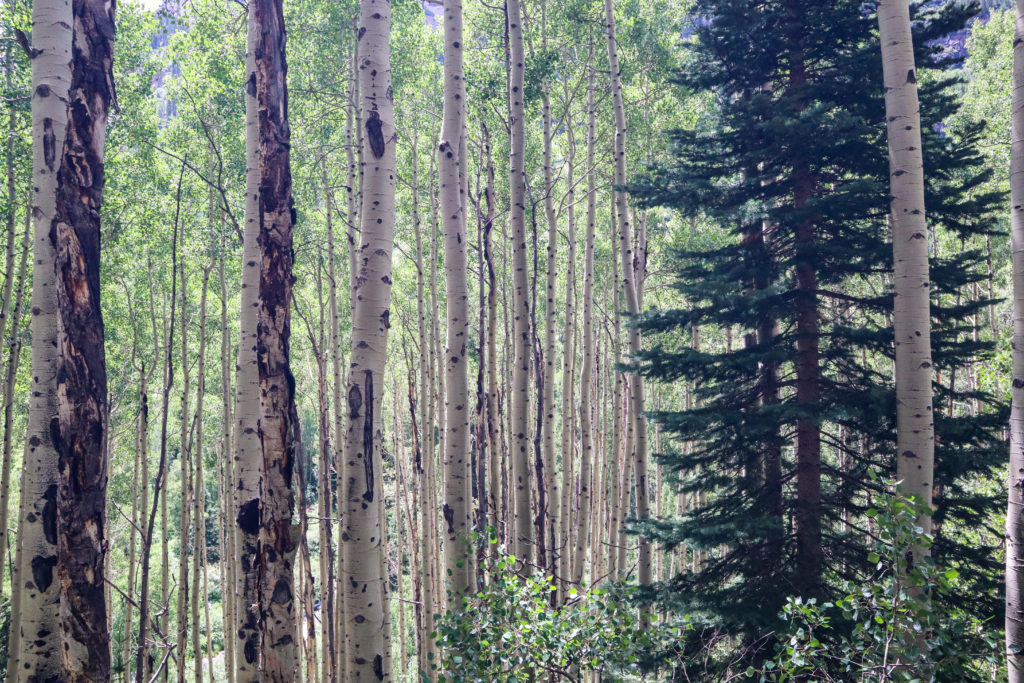
Four Pass Loop (Hard)
If you want the full Maroon Bells Snowmass Wilderness experience and thrive in the backcountry, this trail is for you. It’s named for the four passes that it winds through. Buckskin, Trail Rider, Frigid Air, and West Maroon Passes are all over 12,000 feet.
Typically done counterclockwise, this loop takes 3-4 days to complete. It’s best to do this hike in late summer. Four Pass Loop is not for the faint of heart and requires some previous backpacking experience to be done safely.
I don’t know about you, but this hike is 100% on my bucket list!
Trail Stats (via Alltrails)
- Distance: 25.7 miles
- Elevation Gain: 7,752 feet
- Difficulty: Hard
- Route Type: Loop
- Duration: 3-4 days
- Dog-Friendly: Yes, on leash, but assess difficulty
Crested Butte to Aspen via West Maroon Pass (Hard)
The best time to hike this trail is anytime from July to September.
If you’re hunting for wildflowers or gorgeous aspen foliage, this hike offers a route traversing some of the best in the state of Colorado. July and August offer a visit to the wildflower capitol of Colorado: Crested Butte.
And in September when the aspens change color, you can wander through one of the largest organisms in the world: the grove of aspens that spans from Aspen down towards Kebler Pass and Crested Butte.
Because of the point-to-point nature of this trail, you’ll want to have a ride lined up or you can overnight it and hike back the way you came. Either way, it seems to me that you can’t go wrong with this epic trail.
Trail Stats (via Alltrails)
- Distance: 10.3 miles
- Elevation Gain: 2,240 feet
- Difficulty: Hard
- Route Type: Point to Point
- Duration: ~6 hours
- Dog-Friendly: Yes, on leash, but assess difficulty
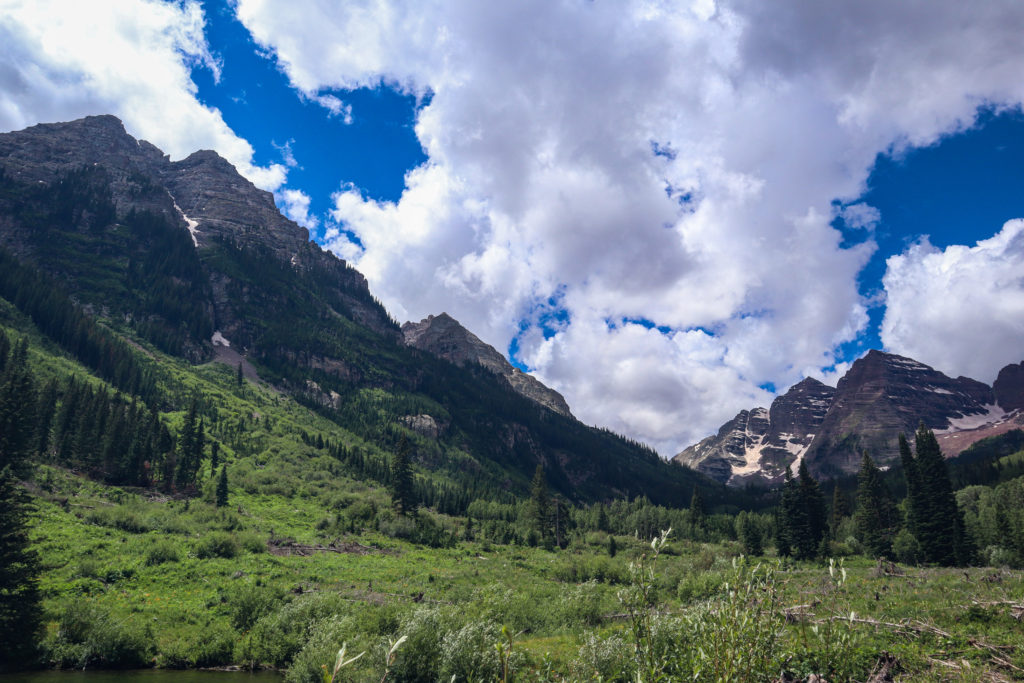
Hiking Gear List
- Breathable hiking attire (find a few of my favorite options at my Amazon Storefront here*)
- Trail Runners or Hiking Boots (my favorite pair from Columbia is linked here)
- Day Pack
- Water Reservoir or Water Bottles (at least 1/2 liter per hour on the trail)
- Electrolytes
- Trail Snacks
- 10 Hiking Essentials (linked here)
- Camera or Phone (use Airplane mode to conserve battery)
Please note that this list is intended for a day hike! Backpacking overnight requires much more gear and preparation.
*this signifies an affiliate link. You can read more about what this means here.
Leave No Trace Principles
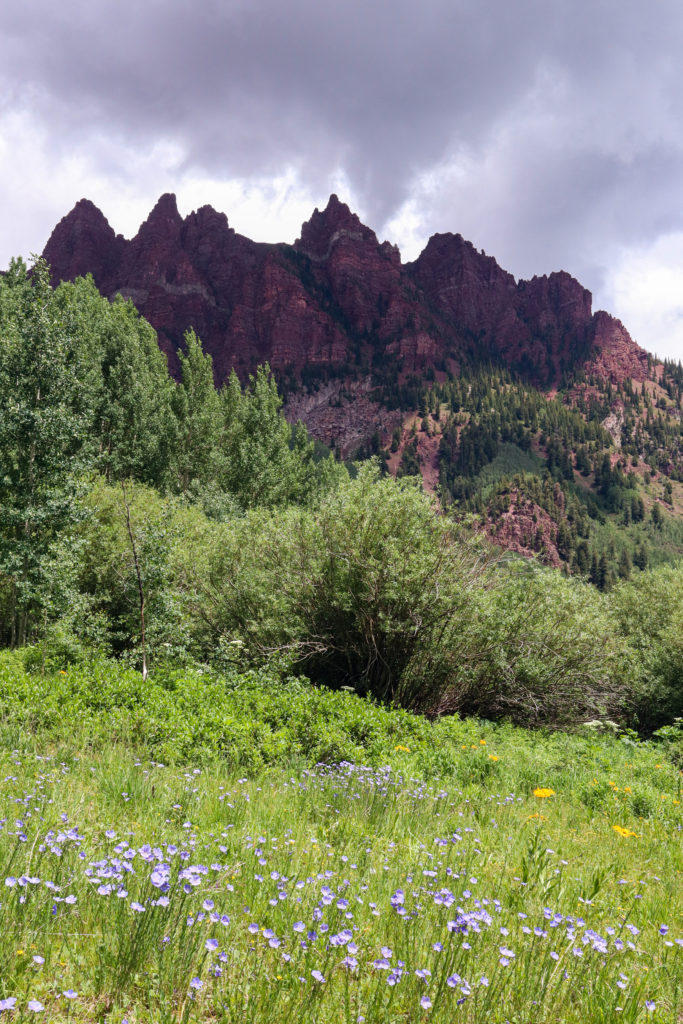
These are the 7 Leave No Trace Principles are the following:
- Plan Ahead and Prepare
- Travel and Camp on Durable Surfaces
- Dispose of Waste Properly
- Leave What You Find
- Minimize Campfire Impacts
- Respect Wildlife
- Be Considerate of Other Visitors
It is essential that we all follow these principles in order to preserve the beauty of Maroon Bells in Colorado and other natural areas for generations to come.
You can learn more about these principles here.
Have I convinced you to explore Maroon Bells?
Liked this post? Pin it for later!
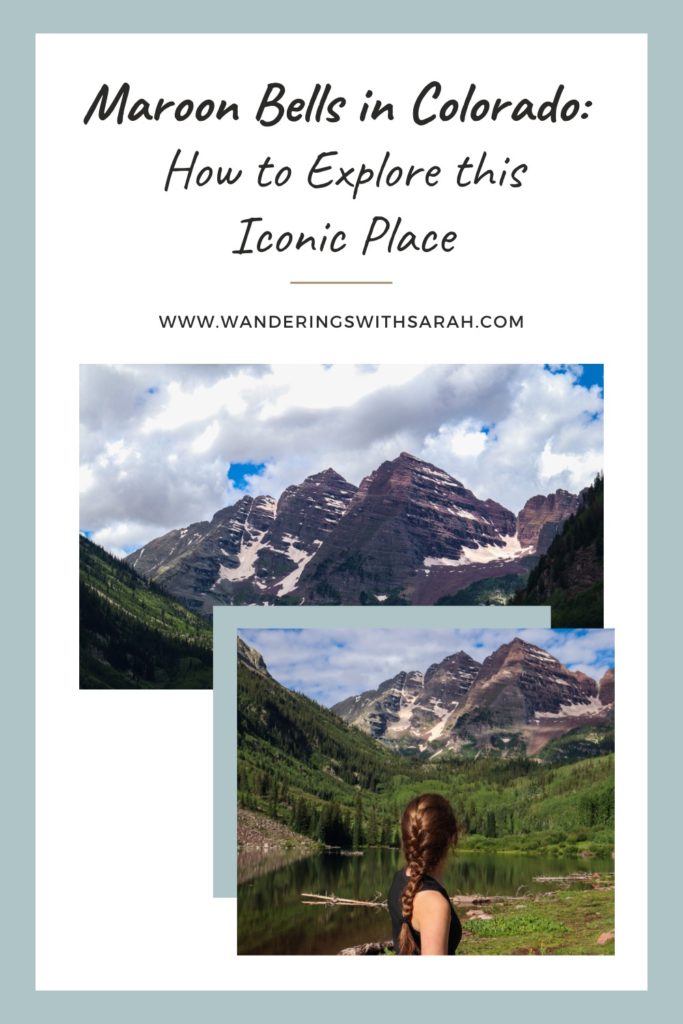
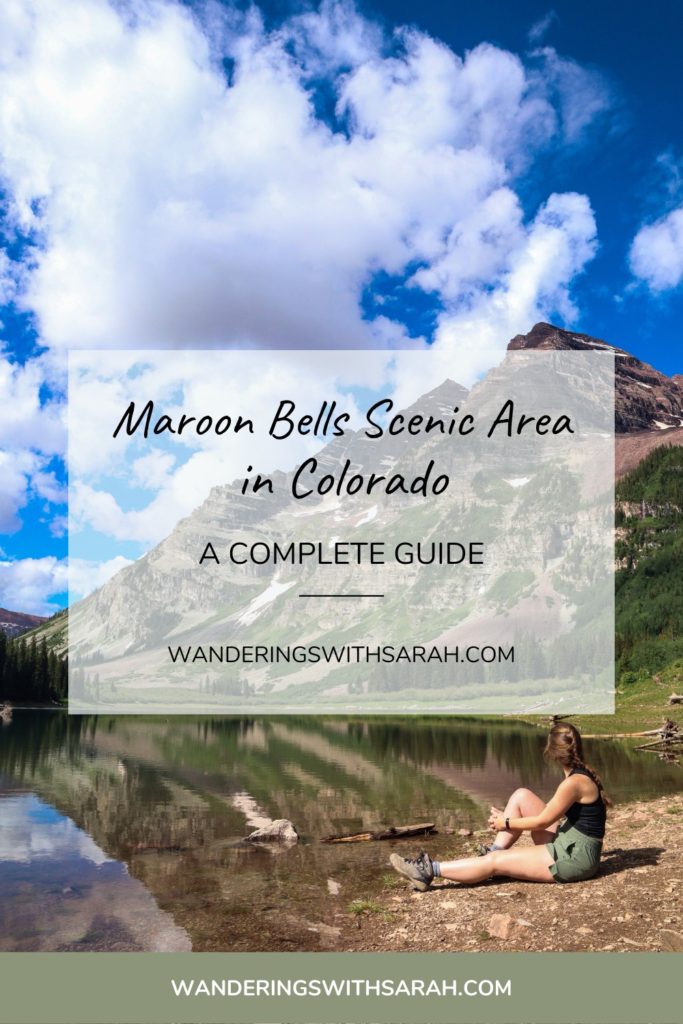
Other Blog Posts
- Best West Michigan Hiking Trails: The Story of My Senior Project
- How to Spend a Fun Morning at Tulip Time in Holland Michigan
- Hocking Hills in Ohio: Best Hikes and Waterfalls in Just 2 Days
Affiliate Link Disclosure: The symbol “*” signifies any links that are affiliate links. This means that I earn commission if you choose to buy something from these links. This comes at no additional cost to you and enables me to keep putting out content for you. If you choose not to purchase through these links, that’s fine too!
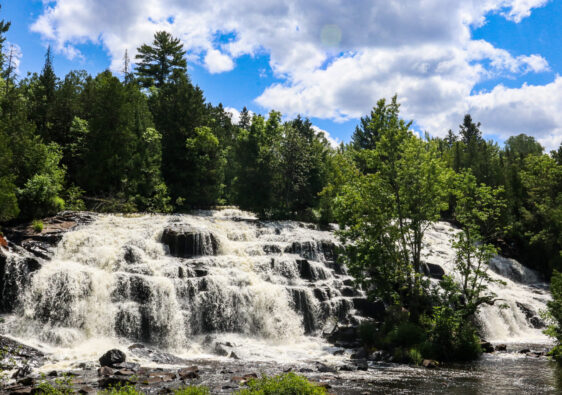
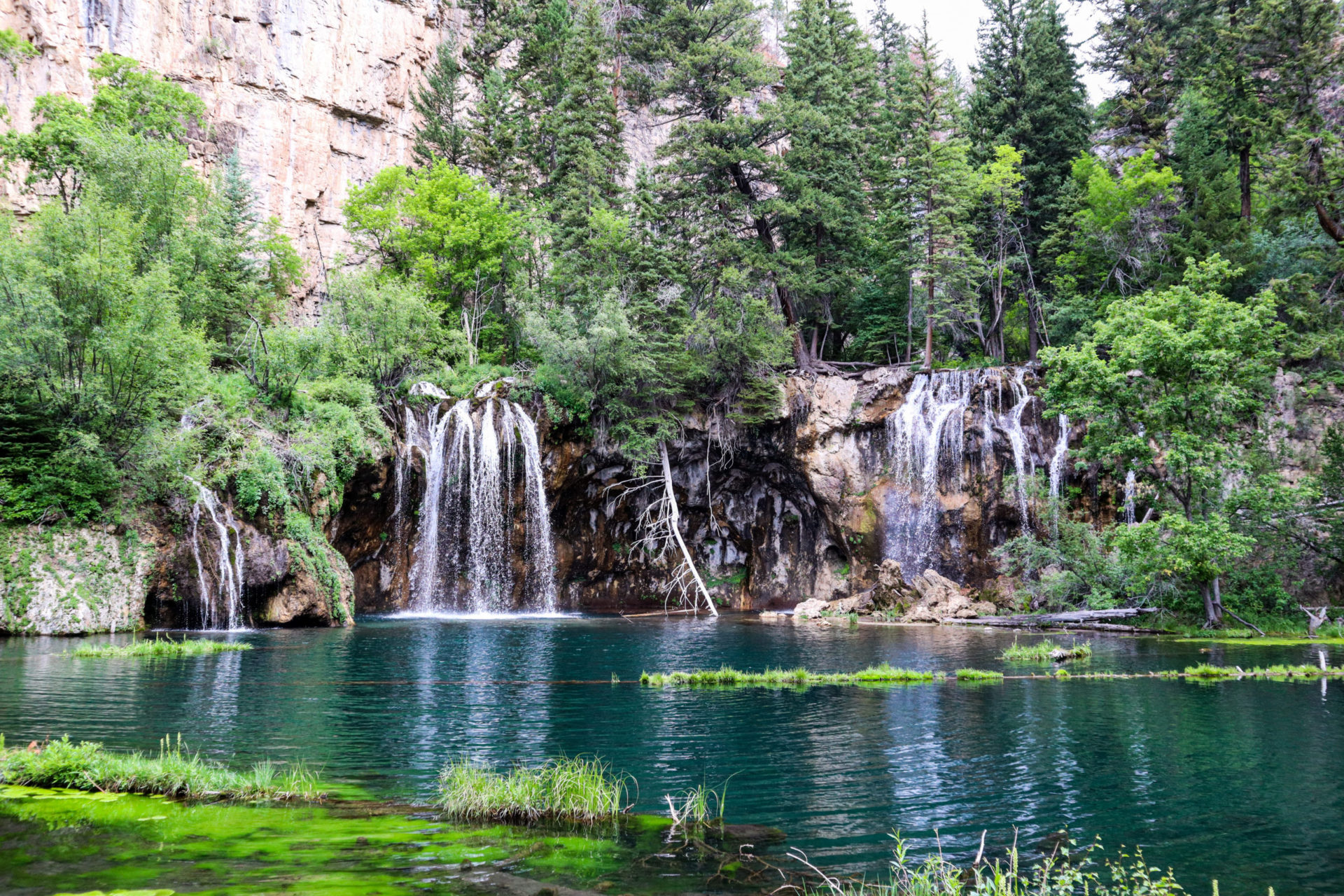
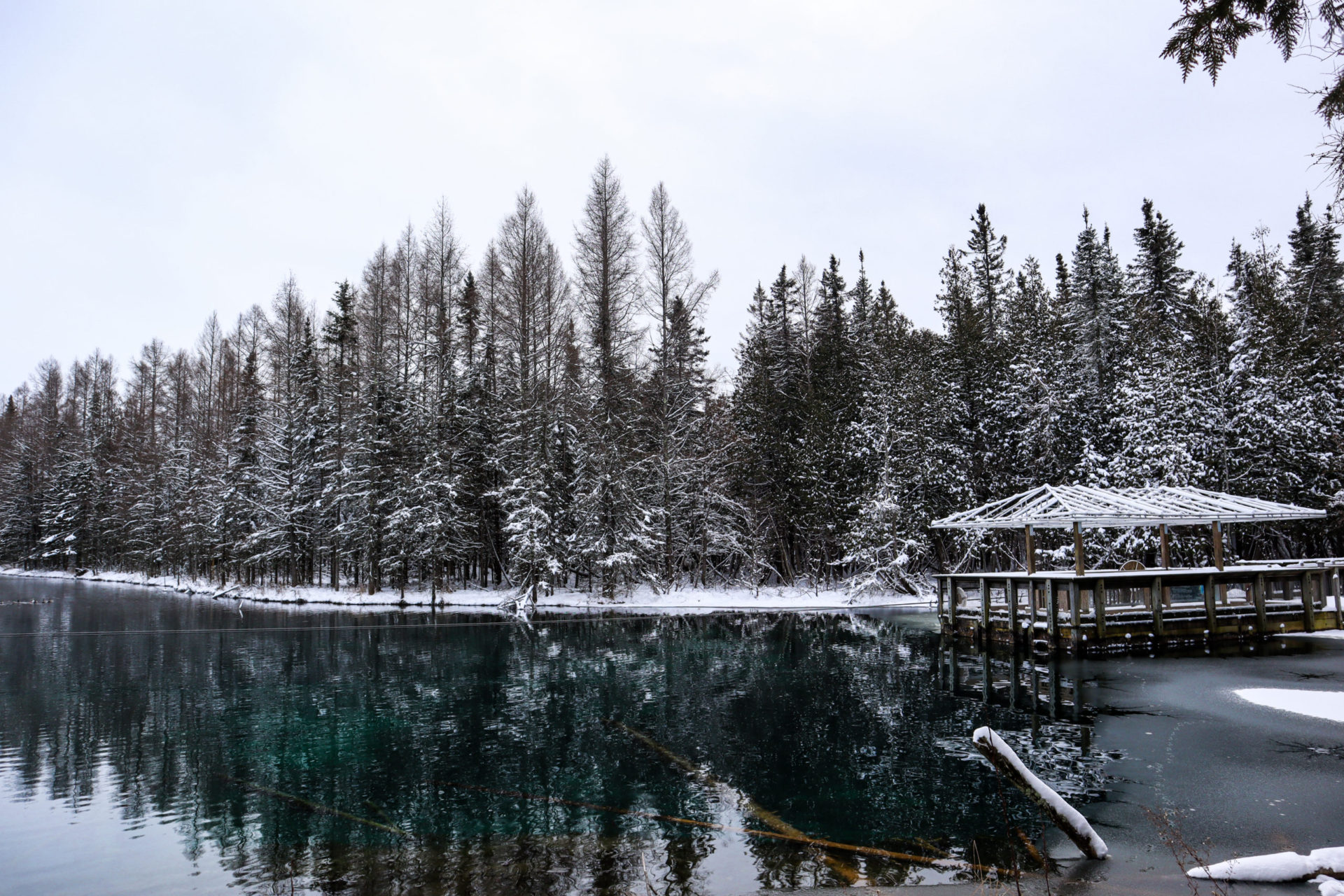
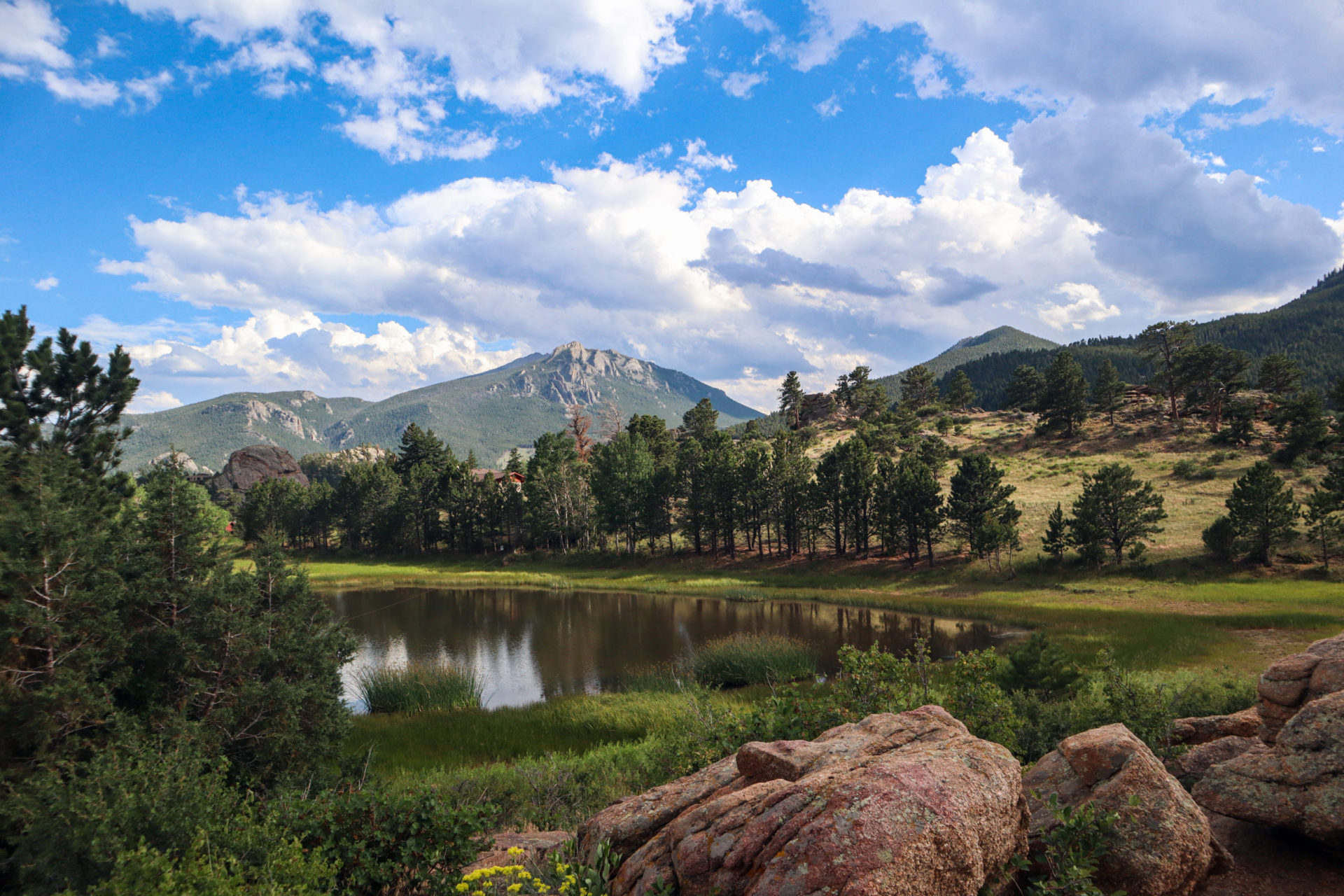
[…] For other Colorado campgrounds in the area near Maroon Bells in Aspen, check out my blog post here. […]